
Salado is a village in Bell County, Texas, United States. Salado was first incorporated in 1867 for the sole purpose of building a bridge across Salado Creek. In 2000, the citizens of Salado voted in favor of reincorporation, before which it was a census-designated place. The population was 2,394 at the 2020 census.
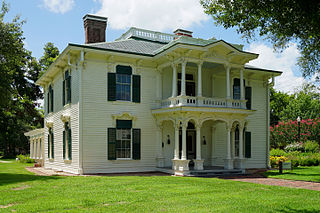
The Sam Bell Maxey House is a historic house in Paris, Lamar County, Texas. Samuel Bell Maxey, a prominent local attorney and later two-term U.S. senator, built the large two-story house after serving as a major general in the Confederate Army. It is built in the High Victorian Italianate style.

Built starting in 1852, the Stagecoach Inn of Salado, Texas, is thought to be the oldest extant structure in the village. The Inn was built as a stagecoach stop along the Chisholm Trail. The simple, two-story wood-frame building is in a frontier vernacular style. The structure was extended several times in the 1940s and 1950s to serve as a restaurant. The inn was listed on the National Register of Historic Places in 1983. The inn has also been a member of Historic Hotels of America, the official program of the National Trust for Historic Preservation, since 2018., although its current name with the organization is the "Shady Villa Hotel."
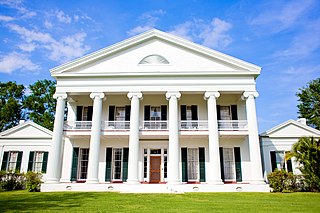
Madewood Plantation House, also known as Madewood, is a former sugarcane plantation house on Bayou Lafourche, near Napoleonville, Louisiana. It is located approximately two miles east of Napoleonville on Louisiana Highway 308. A National Historic Landmark, the 1846 house is architecturally significant as the first major work of Henry Howard, and as one of the finest Greek Revival plantation houses in the American South.

Magoffin Home is located in El Paso, Texas. It was placed on the National Register of Historic Places in 1971. The surrounding area was declared the Magoffin Historic District on February 19, 1985. The home is now known as the Magoffin Home State Historic Site under the authority of the Texas Historical Commission.

The Mansion Row Historic District is a national historic district located at New Albany, Indiana. It features some of the various mansions of the city when New Albany was the largest city in Indiana around the time of the American Civil War. The main section is on Main Street from State Street, to 15th Street. A smaller section is on Market Street from E. 7th Street to E. 11th Street.

Salmon P. Chase Birthplace was the birthplace and childhood home of Salmon P. Chase. It is located about 8 miles (13 km) north of Claremont on New Hampshire Route 12A. The 2+1⁄2-story wood-frame house was built c. 1790, and is a multi-section structure in an L shape. The main block is five bays wide and two deep, with a centered entry that has Greek Revival pilasters on the central entry and on the corners. This block faces west, and two narrower sections extend east from the rear. The first of these sections is also 2+1⁄2 stories, with two chimneys. The easternmost section is 1+1⁄2 stories, and was originally connected to a barn. The house is believed to be well-preserved, but there is no documentary evidence of its appearance in the early 19th century, and it is known to have been moved across the street from its original site in about 1848.
There are several historic homes in the United States which bear the name Colson House, spanning the century from c. 1800 to 1905.

The East End Historic District encompasses a large 19th-century residential area in eastern Galveston, Texas. The area is roughly bounded by Broadway to the south, Market St to the north, 19th St to the west, and 9th street to the east. The area has one of the best-preserved and largest concentrations of 19th-century residential architecture in Texas. It was developed mainly at a time when Galveston was the state's preeminent port. The historic district, designated locally in 1970, was placed on the National Register of Historic Places in 1975 and declared a National Historic Landmark in 1976.
The John Clark House in Clarksdale, Mississippi was built in 1859 with elements of Greek Revival style. It was moved approximately 100 yards (91 m) in 1916 to make way for a grand house, the Italian Renaissance style Cutrer Mansion, to be built in its place. The John Clark House was then remodeled, including that its "two-tiered one-bay porch supported with turned posts was replaced with a then-stylish Colonial Revival porch."

Washington Avenue Historic District is the historic center of Cedarburg, Wisconsin, the location of the early industry and commerce that was key to the community's development. The historic district was listed on the National Register of Historic Places (NRHP) in 1986.

The Stagecoach Inn of Chappell Hill is a historic stagecoach inn at Main and Chestnut Streets in Chappell Hill, Texas, United States.

The Jonesborough Historic District is a historic district in Jonesborough, Tennessee, that was listed on the National Register of Historic Places as Jonesboro Historic District in 1969.

Walnut Grove is an historic Greek Revival-style house in Spotsylvania County, Virginia. The house was built in 1840 on land that was purchased by Jonathan Johnson in 1829. Markings on the exposed oak beams indicate that Walnut Grove was built by William A. Jennings. Jennings was recognized as a master builder of Greek Revival homes during that period. Walnut Grove was added to the National Register of Historic Places in August 2004.

The Charnwood Residential Historic District is a 59.5-acre (24.1 ha) historic district in Tyler, Texas that was listed on the National Register of Historic Places in 1999. It includes works dating from 1870. It includes works designed by Barber & Klutz, James Hubbell and Herbert M. Greene of the firm Hubbell & Greene, and other architects in Tudor Revival, Colonial Revival, and other styles.
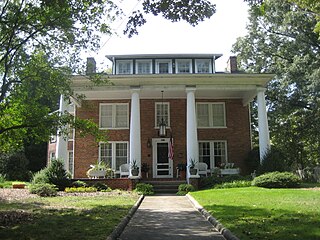
Bumpas-Troy House is a historic home which is located at Greensboro, Guilford County, North Carolina. It was built in 1847, and is a 2+1⁄2-story, three-bay, Greek Revival-style brick dwelling. The front facade features a two-story portico.

Joslin Farm is a historic farm property at 1661 East Warren Road in Waitsfield, Vermont. First developed c. 1830, the farm is home to one of Vermont's shrinking number of round barns. Now used as a bed and breakfast called The Inn at the Round Barn, the farm property was listed on the National Register of Historic Places in 1988.

Lareau Farm is a historic farm property at 48 Lareau Road in Waitsfield, Vermont. First settled in 1794 by Simeon Stoddard and his wife Abiah, two of the town's early settlers, the farmstead includes both a house and barn dating to that period. Now serving primarily as a bed and breakfast inn, the farm property was listed on the National Register of Historic Places in 2016.
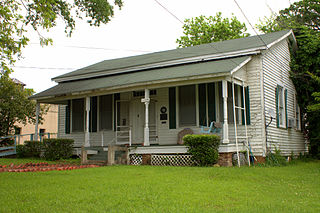
The James Turner House, a one-story Greek Revival style building located on 406 South Washington Avenue in Marshall, Texas, was built by a merchant, George Gammon Gregg to be the home for him and his bride, Mary Ann Wilson, who were married in 1851. It was first located at the southeast corner of Crockett Street and Washington Avenue.
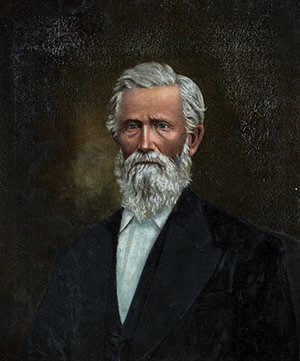
George Washington Baines was an American politician, Baptist preacher, journalist, slaveowner, and educator. He was a co-founder, professor of natural science, and the third president of Baylor University, while the university was located in Independence, Texas, during the American Civil War.





















